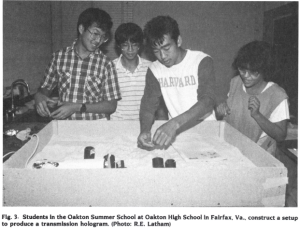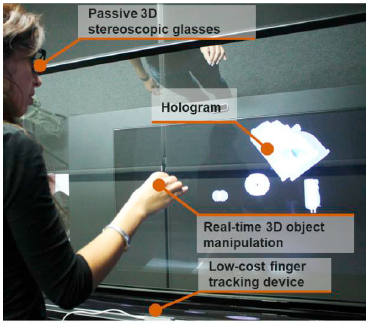Edward Lewis
Holography and Education
Hello, and welcome to the wild imagination of the authors of this book. We will not pretend to be the experts on holographic presentations or instructions but offer possibilities for using holographic technology to enhance the effect of learning on students. We need to first consider some changes that we assume will occur in the future that will promote learning in middle and high school that meets the current basic-level skills such as reading and writing general business documents or creating and managing a project for entry into the real world. Second that technical schools or higher education institutions are facilitating learning based on the needs of society and that the opportunity to attend one or the other is afforded to everyone. Finally, businesses will use this technology to not only facilitate internal training and operations but provide this as a service to others to enhance their respective processes.
Now that you have explored the history and development of holographs in chapters 1 and 2, let’s see how holographic technology can be integrated into the classroom environment. It is important to note that the use of holograms is in its infant stage as a method for learning but is currently used to present courses by visually projecting instructors or lectures in a classroom setting. The latest technology is generally used in higher education. There are many areas of education that hologram technology would provide benefit for learner.
Primary and Secondary School
First, primary and secondary school application can be reviewed. It is interesting that hologram technology advancement has been seemly slow. Articles from 1980’s have indicated that even high school educators have explored making holograms. In one such article from 1984, a high school teacher named Robert Latham in Virginia used grant money for his physics class to build a hologram device. He provided the materials for his class and let them explore setting up and using the makeshift device made from a Metrologic Sandbox Holography and a Physical optics Lab set. (Latham, 1986)

Figure 1: Oakton High School students assembling Holographic project. Photo from R. E. Latham.
Even though producing the hologram was the goal of the project, other learning principles were promoted. Students were engaged with activities in an authentic environment and were required to collaborate setup device and use it. In addition, the students utilized problem-solving skills to resolve construction issues. Mr. Latham focused on the team concept to successfully completed the project of producing a hologram from the materials provided. He divided the class into teams and assigned team members responsibilities. He used a formative approach to verbally test each student on their responsibilities before they began their group’s project. (Latham, 1986) Though the hologram wasn’t directly used to teach students, the building of the holographic device served as a bridge to physics concepts that were previously taught. So, how can holography be used to promote learning?
In Malaysia, students in primary school are encouraged to have fun. They are restricted from testing for the first few years so they can acclimate to the learning environment. Research has shown that learning outcomes were more successful, and motivation increased when 3D technology was used during primary school years. In addition, children’s interest level increased because they could view objects and cognitive load was also reduced because the text or spoken content matched the visual stimulus. (Loh & Shaharuddin, 2019) The study also indicated that children’s cognitive level according to Bloom’s Taxonomy of Cognitive Domain may also be higher because of this learning approach. (Anderson et al., 2001) Holograms can spark curiosity and participation, which is central to children’s learning. (Arnone et al., 2011) A variety of holographic technology has been tested around the world. In Ecuador, researchers have tested fan holograms with secondary students and found similar positive results as in Malaysia. The holograph displays made an instant effect on the children’s education. (Ortega et al., 2020)
Higher Education
Next, focus on higher education and advances spurred on by the pandemic can be explored. The use of holograms for collaboration around the globe has increased. Holographic conference exploration is already occurring in many higher educational institutions. At the University of Texas in Austin, university organizations have been working on using holograms to broadcast courses in which the students and instructors are in separate locations but can see and hear each other. This requires series of cameras and sound equipment on the presenter’s side. The classroom is let up with a glass wall for the projection of the instructor. The instructor can see the students with a panoramic setup of screens to get the sense of physical presence and interaction with the students.
Video 1: Hologram Technology Launches Classroom of the Future | McCombs School of Business
The University of Hawaii at Manoa is another higher educational institution using Hologram technology. In this case, the university is not only broadcasting courses using holographic technology but also plans to create a HoloCampus in partnership with American Samoa Telecommunications Authority and Canadian company, ARHT (Augmented Reality Holographic Telepresence) Media. This partnership would provide students in American Samoa the opportunity to earn degrees from University of Hawaii. This is not an easy task though because the technology requires access to the trans-Pacific fiberoptic cable that runs between the islands. (Hurley, 2019)
There has also been research to test if using a 3D cartoon-like character as a hologram tutor would be a viable alternative to an actual 3D person hologram. The concept was to free instructors from some of the courses and provide consistent instruction from course to course. Software could be used to develop the 3D cartoon hologram characters which could be changed to meet audience needs. Also, cartoon-like characters were selected to eliminate some of the human bias characteristics that may occur from student-teacher interactions. The results indicated that college students were generally interested in the instruction. They were not, though, as confident on the animated tutor’s skill level to assist with academic issues and concerns. (Ali & Ramlie, 2021)
Private and Commercial Sector
Finally, commercial applications of the hologram technology to solve business problems and facilitate organizational training is also advancing. Using holograms to teach new technical skills is a key incentive for many industries and countries to explore this technology. Employee training and development are important elements for organizational success. New employees who need training on skills required a position or current employees who need additional or refresher training to bring him or her up to a required level can benefit from holographic technology. In these scenarios, imagine having the ability to understand the workings of a machine without physically disassembling it. Instead, there would be a hologram that could be manipulated so the parts can be exposed, and functions can be examined. Today virtual reality goggles can be used to view items that are experienced in a 3D space. Some countries are exploring holograms in their industries to address training challenges.
Greece, for example, is updating its Teaching Factory principles to address training requirements for the manufacturing industry using the latest hologram technology. The Teaching Factory 4.0 principles are the recent guidance for conducting training in an authentic interactive environment. This means that students learn while interacting with actual manufacturing facilities and employees. The hologram technology with consist of a mirror and passive glasses plus the students, and employees’ own devices to see the holograms and operational interact with the holograms. (Mavrikios et al., 2019)

Fig 2. Hologram System for Training Factory learning. Photo from ScienceDirect article: Using Holograms for visualizing and interacting with educational content in a Teaching Factory.
The nursing profession has also looked into the benefits of using holograms in its student training. A study in Taiwan conducted on third-year nursing students indicated that courses that incorporated hologram technology increased students’ retention of material and understanding of the concepts. In this study, students had virtual reality headsets for the hologram displays but the results were similar to other studies of training without headsets. (Chen et al., 2021)
In the next chapter, future hologram technology and some of the companies making it will be discussed.
References:
Ali, A. Z. M., & Ramlie, M. K. (2021). Examining the User Experience of Learning with a Hologram Tutor in the Form of a 3D Cartoon Character. Education and Information Technologies, 26(5), 6123–6141.
Anderson, L. W., Krathwohl, D. R., Airasian, P. W., Cruikshank, K. A., Mayer, R. E., Pintrich, P. R., Raths, J., & Wittrock, M.C. (2001). A Taxonomy for Learning, Teaching, and Assessing: A Revision of Bloom’s Taxonomy of Educational Objectives (Complete Edition). New York: Longman.
Arnone, M. P., Small, R. V., Chauncey, S. A., & Mckenna, H. P. (2011). Curiosity, Interest and Engagement in Technology-Pervasive Learning Environments: A New Research Agenda. Education Tech Research De, 59(2), 181–198.
Chen, C.-J., Chen, Y.-C., Lee, M.-Y., Wang, C.-H., & Sung, H.-C. (2021). Effects of three-dimensional holograms on the academic performance of nursing students in a health assessment and practice course: A pretest-intervention-posttest study. Nurse Education Today, 106. https://doi-org.proxyiub.uits.iu.edu/10.1016/j.nedt.2021.105081.
Hologram Technology Launches Classroom of the Future | McCombs School of Business. Retrieved from Hologram Technology Launches Classroom of the Future | McCombs School of Business – YouTube
Hurley, T. (2019, August 25). University of Hawaii lecture beamed by hologram to American Samoa. Honolulu Star-Advertiser.
Latham, R. E. (1986). Holography in the science classroom. Physics Teacher, 24, 395–400. https://doi-org.proxyiub.uits.iu.edu/10.1119/1.2342064
Loh, N-H., & Shaharuddin, S. S. B. (2019). Corporate Social Responsibility (Csr) Towards Education: The Application and Possibility of 3D Hologram to Enhance Cognitive Skills of Primary School Learners. International Journal of Business & Society, 20(3), 1036–1047.
Ortega, M. X. P., Ramírez, J. C. D., Castro, J. W. V., Carrión, J. L. A., Carvajal, A. A. A. & Segarra, A. N. G. (2020). Application of the technical – pedagogical resource 3D holographic LED-fan display in the classroom. Smart Learning Environments, 7(1), 1–13. https://doi-org.proxyiub.uits.iu.edu/10.1186/s40561-020-00136-5.
Mavrikios, D., Alexopoulos, K., Georgoulias, K., Makris, S., Michalos, G., & Chryssolouris, G. (2019). Using Holograms for visualizing and interacting with educational content in a Teaching Factory. Procedia Manufacturing, 31, 404–410. https://doi-org.proxyiub.uits.iu.edu/10.1016/j.promfg.2019.03.063.
